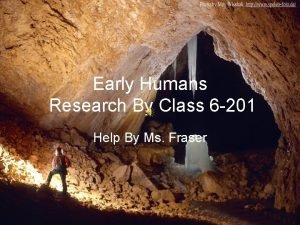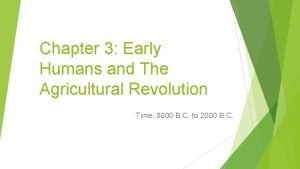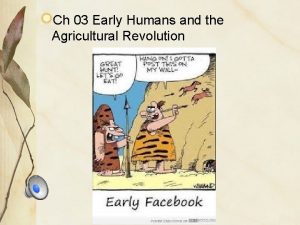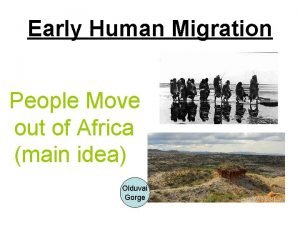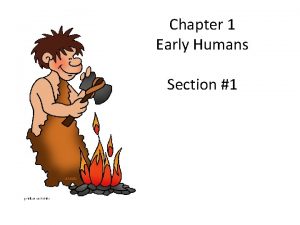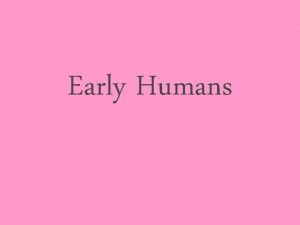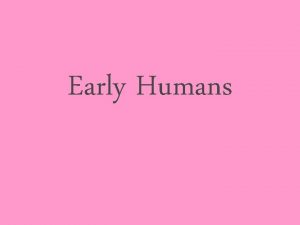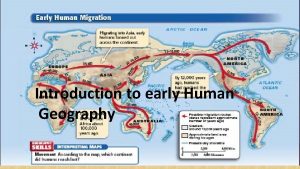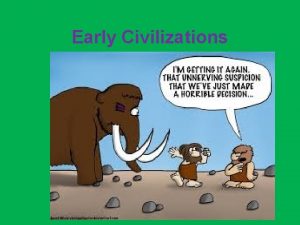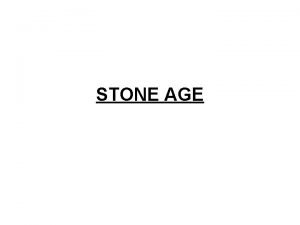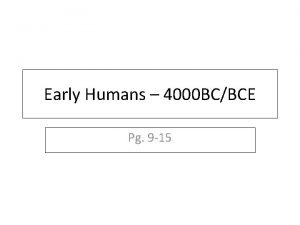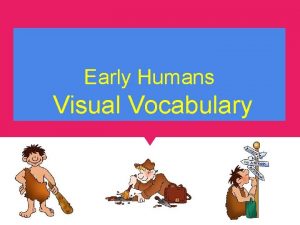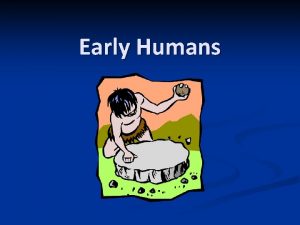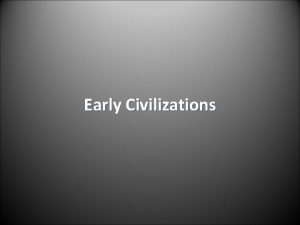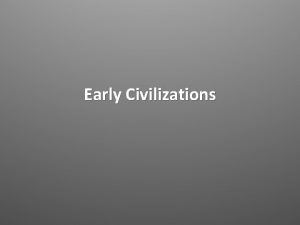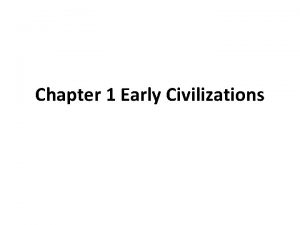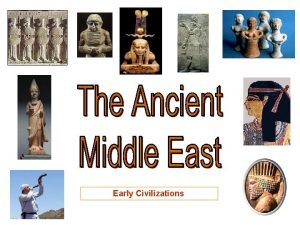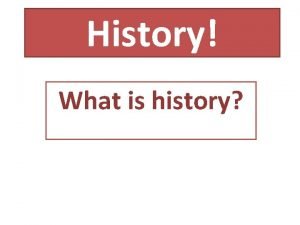Early Humans Early Humans History the study of




























- Slides: 28

Early Humans

Early Humans • History: the study of humans in the past – Tells what they did and what happened to them • Historians – People who study and write about the human past – They tell us that history began about 5, 500 years ago

Prehistory • The story of humans really begins in “prehistory” – before people developed writing systems

Tools of Discovery • What we know of prehistoric people comes from the things they left behind • These things are called artifacts (weapons, tools, and other things made by humans)

Tools of Discovery • Archaeologists dig these things up where settlements may have once existed

Tools of Discovery • Anthropologists focus on the study of human society – How people developed and how they related to one another http: //www. history. com/shows/mankind-the-story-of-all-of-us/videos/mankind-the-story-of-all-of-us-the-earliest-humans

The Stone Age • The early period of human history is called the Stone Age • It is divided into two periods – The Paleolithic Age (“old stone”); lasted until about 8000 BC – The Neolithic Age (“new stone”); lasted until about 4000 BC

What the Stone Age is NOT

What the Stone Age Actually Looked Like

Who were the Hunter Gatherers? • Early humans spent most time searching for food – They hunted animals, ate insects, and gathered various fruits and vegetables • Because of this lifestyle, these people were always on the move (nomads)

Who were the Hunter Gatherers? • Nomads traveled in groups of about 30 – made the search for food easier and safer • Women stayed close to the camp – searched for berries, nuts, and grains

Who were the Hunter Gatherers? • Men hunted – had to learn the habits of animals, and make tools for the kill • at first they used things like clubs, • eventually spears, traps, and the bow and arrow were invented

Adapting to the Environment • those who lived in warm climates needed little clothing or shelter • those who lived in the cold sought shelter in caves – eventually new kinds of shelter was invented (tents made of animal hides)

Taming Fire • Paleolithic people made a great discovery when they learned to tame fire – It lit up the dark, scared away wild animals, and cooked their food

What were the Ice Ages? • Long periods of extreme cold (from 100, 000 BC – 8, 000 BC) • Thick ice sheets covered parts of Europe – Was a threat to human life

What were the Ice Ages? • Humans had to adapt by changing their diet, building sturdier shelters, and using animal furs to make warmer clothes

Language, Art, and Religion • The development of spoken language made it easier for people to work together and pass on knowledge

Language, Art, and Religion • Early humans not only expressed themselves in words, but in art – Crushed colored rocks to make powders for paint • Dabbed it on cave walls

Invention of Tools • Paleolithic people were the first to use technology – Tools and methods to help humans perform tasks • They often used flint (a hard stone) to make tools – arrows, axes, spears, etc.

Invention of Tools

Invention of Tools • People became more skilled at making tools over time • They crafted smaller and sharper tools like fishhooks and needles

Neolithic Times • After the last Ice Age ended, people began to change their way of life • They began to domesticate (tame) animals and plants for human use

Neolithic Times • During this time people learned how to grow food – Now people could stay in one place and grow grains and vegetables • Farming eventually replaced hunting and gathering – Marked the beginning of the Neolithic Age

The Growth of Villages • Farmers could now stay in one place – Had to stay close to their field to water the plants, keep wild animals away, and harvest their crops • They began to live in villages where they built their permanent homes

The Growth of Villages • The earliest known communities have been found in the Middle East – One of the oldest is Jericho – Another is Catal Hüyük

Benefits of a Settled Life • Settled life brought Neolithic people greater security than ever before • Steady food supply meant healthy, growing populations – Meant more workers to produce bigger crop

Benefits of a Settled Life • Because villagers produced more than they needed, they began to trade • People began to practice specialization – Development of different kinds of jobs (other than farming)

The Use of Metals • In some places toolmakers began to work with metals like copper • Eventually craftspeople in Asia began mixing copper with bronze – More durable
 How did early humans live
How did early humans live Chapter 3 early humans and the agricultural revolution
Chapter 3 early humans and the agricultural revolution Dominic jordan
Dominic jordan Early humans chapter 1 section 1
Early humans chapter 1 section 1 Lesson 1 early humans
Lesson 1 early humans Early humans and the agricultural revolution answer key
Early humans and the agricultural revolution answer key Migratory paths of early humans
Migratory paths of early humans Early cpr and early defibrillation can: *
Early cpr and early defibrillation can: * Hình ảnh bộ gõ cơ thể búng tay
Hình ảnh bộ gõ cơ thể búng tay Ng-html
Ng-html Bổ thể
Bổ thể Tỉ lệ cơ thể trẻ em
Tỉ lệ cơ thể trẻ em Gấu đi như thế nào
Gấu đi như thế nào Glasgow thang điểm
Glasgow thang điểm Chúa yêu trần thế alleluia
Chúa yêu trần thế alleluia Kể tên các môn thể thao
Kể tên các môn thể thao Thế nào là hệ số cao nhất
Thế nào là hệ số cao nhất Các châu lục và đại dương trên thế giới
Các châu lục và đại dương trên thế giới Cong thức tính động năng
Cong thức tính động năng Trời xanh đây là của chúng ta thể thơ
Trời xanh đây là của chúng ta thể thơ Cách giải mật thư tọa độ
Cách giải mật thư tọa độ 101012 bằng
101012 bằng Phản ứng thế ankan
Phản ứng thế ankan Các châu lục và đại dương trên thế giới
Các châu lục và đại dương trên thế giới Thể thơ truyền thống
Thể thơ truyền thống Quá trình desamine hóa có thể tạo ra
Quá trình desamine hóa có thể tạo ra Một số thể thơ truyền thống
Một số thể thơ truyền thống Cái miệng nó xinh thế chỉ nói điều hay thôi
Cái miệng nó xinh thế chỉ nói điều hay thôi Vẽ hình chiếu vuông góc của vật thể sau
Vẽ hình chiếu vuông góc của vật thể sau
